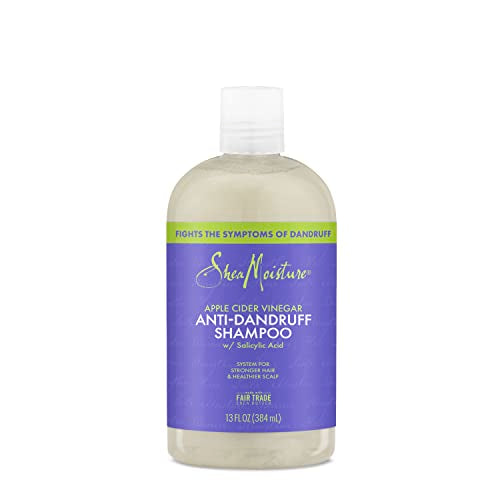
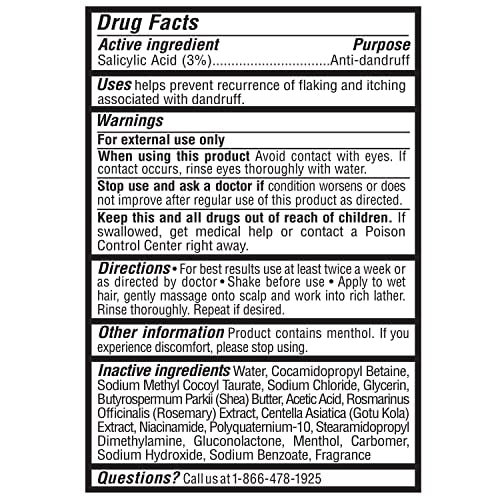
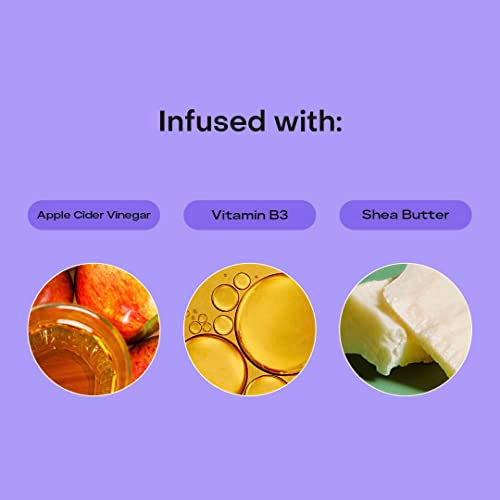

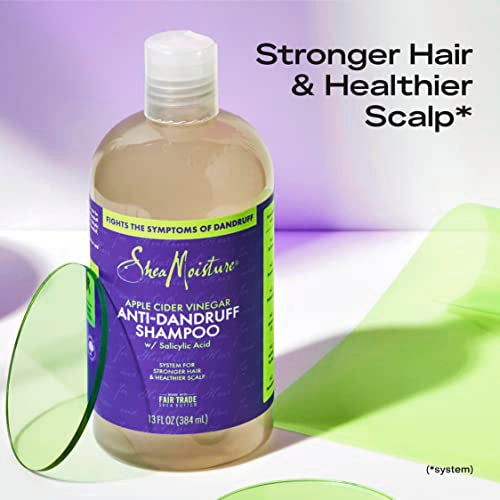
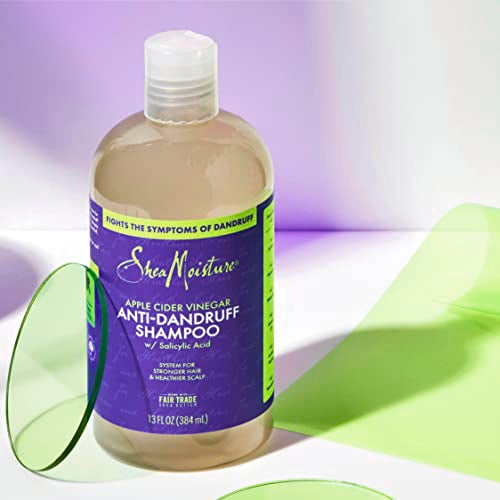
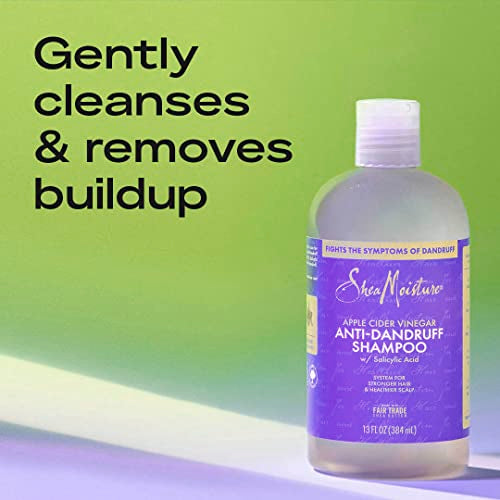
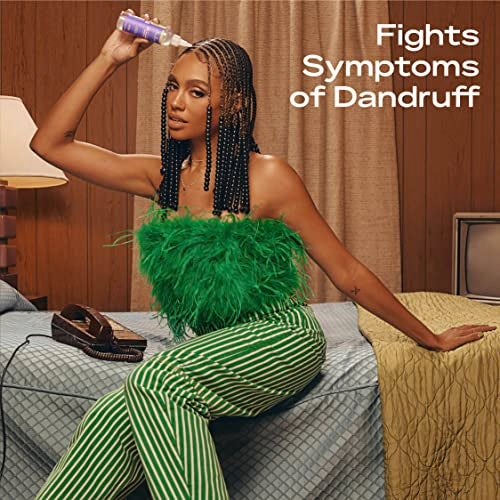

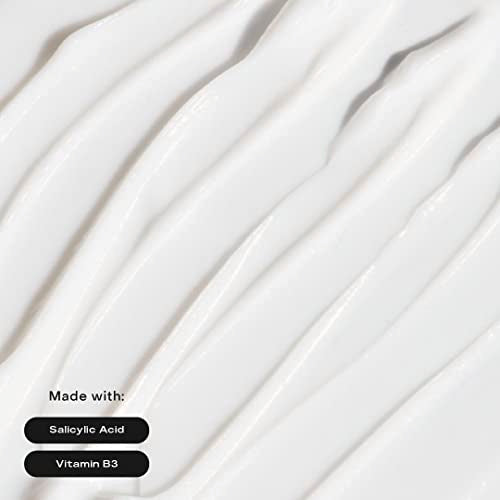
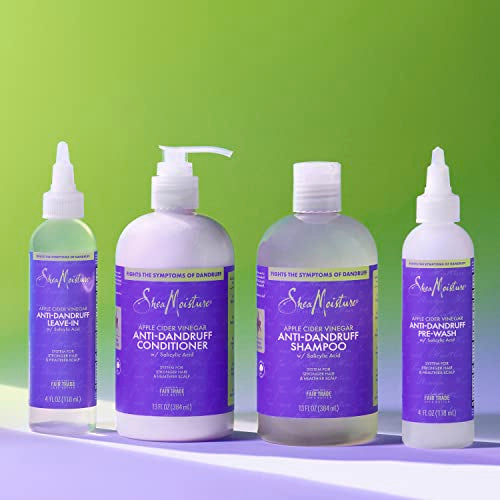
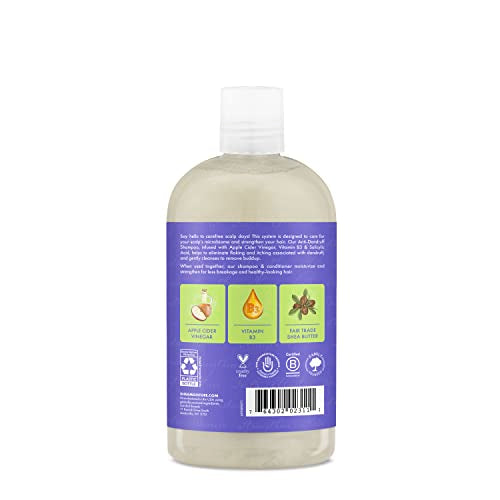

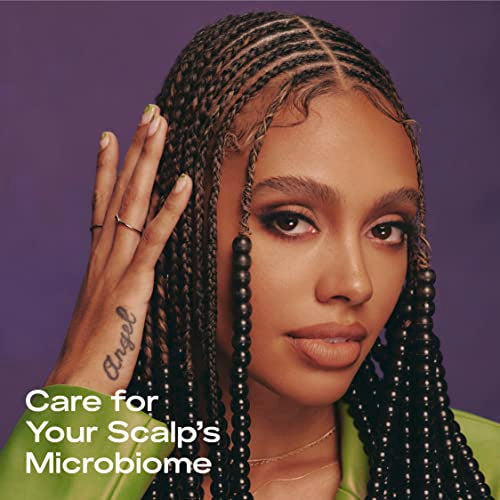
SheaMoisture Anti-Dandruff Shampoo - Strengthens Hair, Nourishes Scalp - Apple Cider Vinegar, 13oz


Stearamidopropyl Dimethylamine
High RiskStearamidopropyl dimethylamine is a lipid-based compound often used as a conditioning agent in hair care and cosmetic products. It functions primarily as an emulsifier and surfactant, enhancing the texture and manageability of hair by reducing static and improving moisture retention.
Sustai Insights
This ingredient offers functional benefits such as effective conditioning and emulsification in formulations. However, it presents moderate allergenic concerns, while its health risks related to cancer and reproductive toxicity are low. Environmental risks include potential pollutant status, and it is subject to high usage restrictions by regulatory bodies. Overall, it is assessed as high risk, particularly concerning regulatory compliance and potential adverse health effects. Alternatives may include plant-derived emulsifiers or conditioning agents that offer improved safety profiles.
Cocamidopropyl Betaine
High RiskCocamidopropyl betaine is a synthetic surfactant derived from coconut oil, commonly used in personal care products for its mild cleansing and foaming properties. It functions as a surfactant, emulsifier, and thickening agent, contributing to the texture and performance of formulations.
Sustai Insights
Cocamidopropyl betaine offers functional benefits as a gentle surfactant, enhancing product foaming and texture. However, it may pose low to moderate allergenic risks and is subject to high use restrictions due to contamination concerns. Regulatory bodies have advised on its safe levels of usage, categorizing its risk level as high overall. Users should practice caution, particularly with sensitive populations, and consider alternatives like naturally derived surfactants for safer formulations.
Fragrance
High RiskFragrance refers to a mixture of aromatic compounds used in products to provide scent. It is commonly listed as 'fragrance' or 'parfum' on product labels and can serve various functions, including enhancing user experience and masking undesirable odors.
Sustai Insights
Fragrance offers functional benefits by improving product appeal; however, it poses significant health risks, notably a high likelihood of causing allergies and allergic contact dermatitis. Environmental risks include potential pollution and endocrine disruption, though its overall carcinogenicity is low. Regulatory bodies have noted concerns regarding its use, leading to a high-risk classification. Safe usage practices should be observed, and alternatives such as natural essential oils are recommended for those sensitive to synthetic fragrances.
Sodium Hydroxide
High RiskSodium hydroxide is a highly caustic and reactive inorganic compound commonly used as a pH adjuster in various products. It is effective in neutralizing acids and plays a role in the production of soaps and detergents.
Sustai Insights
Sodium hydroxide serves essential functions, particularly in adjusting pH levels, but poses significant health risks, including skin and eye irritation. It is subject to high usage restrictions due to its corrosive nature. Environmental concerns include its potential to pollute water sources and contribute to ecosystem damage. Regulatory bodies have imposed strict guidelines on its use, indicating a high-risk profile for products containing this ingredient. Safe handling practices are crucial, and alternatives include milder pH adjusters, emphasizing the need for caution in its application.
Rosmarinus Officinalis (Rosemary) Leaf Extract
Medium RiskRosemary leaf extract is produced from the leaves of the Rosmarinus officinalis plant. It is commonly used in cosmetic formulations for its potential antioxidant properties and fragrance. The extract may also contribute to the preservation of products due to its antimicrobial characteristics.
Sustai Insights
Rosemary leaf extract offers functional benefits such as antioxidant and antimicrobial properties, which can enhance product stability and shelf-life. It is generally considered low risk for carcinogenicity and reproductive toxicity, but it carries a moderate potential for allergic reactions. Environmentally, it poses low risk with no significant pollutant or bioaccumulation concerns. Regulatory bodies have not placed significant restrictions on its use, although some verified products cannot contain certain concentrations. Overall, the ingredient's risk level is medium, necessitating careful usage practices to mitigate allergic responses.
Sodium Benzoate
Medium RiskSodium benzoate is a preservative commonly used in food and cosmetic products to prevent microbial growth and extend shelf life. It is derived from benzoic acid and is effective at low concentrations, often used in acidic environments like beverages and condiments.
Sustai Insights
Sodium benzoate serves effectively as a preservative, contributing to product stability and safety. It is generally recognized as safe with low concerns for carcinogenicity, allergies, and reproductive toxicity, though it faces moderate use restrictions in some regions. Environmental risks include its potential as a pollutant, but it does not bioaccumulate significantly. Regulatory bodies have issued advisories regarding its concentration in products. Overall, the risk level is assessed as medium, with safe usage practices recommended. Alternatives such as potassium sorbate may provide similar benefits with potentially lower restrictions.
Acetum
Low RiskAcetum, commonly known as vinegar, is a solution of acetic acid in water. It is often used in food preservation, flavoring, and culinary applications. Acetum functions as a natural preservative and can aid in food safety by inhibiting the growth of certain bacteria.
Sustai Insights
Acetum offers functional benefits as a preservative and flavoring agent, while being biodegradable and derived from renewable sources. Health risks are low, with minimal concerns regarding carcinogenicity, allergies, or reproductive toxicity. Environmental risks are negligible, as it does not contribute significantly to pollution or bioaccumulation. Regulatory assessments indicate no current restrictions. Overall, its risk level is low, making it a safe choice for use in various applications.
Water
Low RiskWater is a clear, colorless liquid essential for various biological processes. It serves as a solvent in formulations, facilitating the dissolution of other ingredients and enhancing product texture and application. Additionally, water plays a crucial role in hydration and is a key component in many cosmetic and personal care products.
Sustai Insights
Water is an effective solvent and hydrator, contributing to the texture and efficacy of formulations. It is biodegradable and generally regarded as safe, with low concerns regarding carcinogenicity, allergies, and reproductive toxicity. However, excessive water usage can lead to environmental concerns, particularly regarding resource depletion. Regulatory bodies do not impose restrictions on water use in cosmetics. Overall, the risks associated with water are low, making it a safe and essential ingredient.
Niacinamide
Low RiskNiacinamide, also known as nicotinamide, is a form of vitamin B3 (niacin) that serves various functions in skincare and cosmetic products. It is often used for its potential benefits in improving skin texture, enhancing moisture retention, and supporting the skin's barrier function.
Sustai Insights
Niacinamide provides functional benefits such as enhancing skin hydration and improving the appearance of uneven skin tone. It is generally recognized as safe, with low concerns regarding carcinogenicity, allergies, or reproductive toxicity. However, enhanced skin absorption may pose risks for sensitive individuals. Regulatory bodies impose few restrictions on its use, and it is considered low risk overall. For safer alternatives, options like panthenol may be considered. Overall, niacinamide is a low-risk ingredient when used appropriately.
Sodium Methyl Cocoyl Taurate
Low RiskSodium methyl cocoyl taurate is a sodium salt derived from coconut fatty acids, primarily used as a mild surfactant and foaming agent in personal care products. It helps to cleanse and stabilize formulations, contributing to improved texture and performance.
Sustai Insights
Sodium methyl cocoyl taurate is recognized for its effective surfactant properties, providing gentle cleansing and foam production in formulations. It is considered low risk for health concerns such as carcinogenicity and allergenic potential, with minimal irritation noted. Environmentally, it poses low hazards with no significant bioaccumulation or pollution risks. Regulatory bodies, including ECHA, indicate no current restrictions. Overall, it presents a low risk profile, making it a viable choice in personal care applications. Safe usage practices are recommended, and alternatives may include other mild surfactants.
Gluconolactone
Low RiskGluconolactone is a lactone that functions primarily as a humectant and exfoliant in cosmetic products. It is derived from gluconic acid and is used to improve skin hydration and texture. This ingredient is known for its compatibility with various skin types and its ability to enhance product stability.
Sustai Insights
Gluconolactone offers functional benefits as an effective humectant, promoting skin hydration and serving as a gentle exfoliant. It is biodegradable and has low allergenic potential. Health risks are minimal, with low concerns for carcinogenicity, immunotoxicity, and reproductive toxicity. Environmental risks are also low, with no known pollutant or bioaccumulative effects. Regulatory bodies, including the FDA, have not imposed restrictions on its use. Overall, the risk level associated with gluconolactone is low, making it a safe choice in cosmetic formulations.
Carbomer
Low RiskCarbomer is a large polymeric chemical compound primarily used as a thickening agent in various cosmetic and personal care products. It enhances the texture and stability of formulations, making it effective in creams, gels, and lotions.
Sustai Insights
Carbomer serves as an effective thickening agent, improving product texture and stability. It is considered low-risk concerning health concerns such as carcinogenicity, allergenicity, and reproductive toxicity. While irritation may occur with skin or eye contact, the overall health and environmental risks are minimal. Regulatory bodies have not placed significant restrictions on carbomer, supporting its safety for use in formulations. Safe usage practices should be followed to minimize irritation potential. Alternatives like xanthan gum or guar gum may provide similar benefits with a natural profile. Overall, the ingredient is assessed as low risk.
Vegetarian Glycerin
Low RiskVegetarian glycerin, also known as glycerol, is a colorless, odorless, and viscous liquid derived from plant sources. It is primarily used as a humectant, solvent, and emollient in various personal care products, helping to retain moisture and improve texture.
Sustai Insights
Vegetarian glycerin offers functional benefits as an effective humectant, promoting hydration and skin smoothness. It is biodegradable and typically sustainably sourced. Health risks associated with glycerin are low, with no significant concerns for carcinogenicity, allergens, or reproductive toxicity. Environmental risks are minimal, and it is not subject to major regulatory warnings. Overall, the risk level for this ingredient is low, making it a safe choice in formulations. Safe usage practices include ensuring proper concentrations in products, and alternatives such as propylene glycol exist but may have differing properties.
Neomenthol
Low RiskNeomenthol is a menthol derivative commonly used for its cooling sensation in cosmetic and topical formulations. It acts primarily as a fragrance component and a soothing agent, contributing to the sensory attributes of products such as creams and ointments.
Sustai Insights
Neomenthol offers functional benefits, including its cooling effect and soothing properties in topical applications. It is not associated with significant health risks, as concerns regarding carcinogenicity, allergies, and toxicity are low. Environmentally, it poses minimal risks and is not classified as a pollutant. Regulatory status indicates no current restrictions. Overall, its risk level is assessed as low, making it a safe option for use in personal care products.
Butyrospermum Parkii (Shea) Butter
Low RiskButyrospermum parkii (shea) butter is a vegetable fat derived from the nuts of the shea tree. It is commonly used in cosmetic formulations for its emollient properties, providing moisture and improving skin texture. Additionally, shea butter is known for its ability to enhance the stability of products and deliver a creamy texture.
Sustai Insights
Shea butter offers functional benefits as an effective moisturizer, enhancing skin barrier function and texture. It is sustainably sourced and biodegradable, contributing to eco-friendliness. Health-wise, it is associated with low risks for carcinogenicity, allergies, and reproductive toxicity. Environmental impacts are minimal, with no significant pollutant potential identified. Regulatory assessments indicate no current restrictions. Overall, the ingredient presents a low risk, making it a favorable choice in cosmetic formulations.
Polyquaternium 10
Low RiskPolyquaternium-10 is a synthetic polymer used primarily as a conditioning agent in cosmetic products. It enhances the texture and feel of hair and skin, providing moisture retention and improved manageability. This ingredient is known for its film-forming properties, which can help reduce frizz and static.
Sustai Insights
Polyquaternium-10 offers functional benefits in enhancing moisture retention and improving product texture. It is considered to have low health risks, with minimal concerns regarding carcinogenicity, allergenic potential, and neurotoxicity. Environmentally, it poses low ecotoxicity and is not known to bioaccumulate. Regulatory assessments indicate no significant restrictions, categorizing it as low risk overall. For safe use, it is recommended to follow product guidelines. Alternatives include natural conditioning agents like guar gum or xanthan gum for those seeking plant-based options.
Sea Salt
Low RiskSea salt is a mixture of inorganic salts derived primarily from the evaporation of seawater. It consists mainly of sodium chloride, with minor amounts of other minerals. Sea salt is commonly used as a seasoning and preservative in food products and may also have applications in cosmetics and personal care items.
Sustai Insights
Sea salt serves as an effective flavor enhancer and preservative, contributing to the taste and shelf-life of food products. It is generally considered safe with low risk for health concerns such as cancer, allergies, and reproductive toxicity. Environmental impact is minimal, as it does not contribute significantly to pollution or bioaccumulation. Regulatory bodies, including the FDA, currently do not impose restrictions on its use. Overall, the risk level associated with sea salt is low, making it a widely accepted ingredient with no significant adverse effects reported.
Acetum
Low RiskAcetum, commonly known as vinegar, is a solution of acetic acid in water. It is often used in food preservation, flavoring, and culinary applications. Acetum functions as a natural preservative and can aid in food safety by inhibiting the growth of certain bacteria.
Sustai Insights
Acetum offers functional benefits as a preservative and flavoring agent, while being biodegradable and derived from renewable sources. Health risks are low, with minimal concerns regarding carcinogenicity, allergies, or reproductive toxicity. Environmental risks are negligible, as it does not contribute significantly to pollution or bioaccumulation. Regulatory assessments indicate no current restrictions. Overall, its risk level is low, making it a safe choice for use in various applications.
Water
Low RiskWater is a clear, colorless liquid essential for various biological processes. It serves as a solvent in formulations, facilitating the dissolution of other ingredients and enhancing product texture and application. Additionally, water plays a crucial role in hydration and is a key component in many cosmetic and personal care products.
Sustai Insights
Water is an effective solvent and hydrator, contributing to the texture and efficacy of formulations. It is biodegradable and generally regarded as safe, with low concerns regarding carcinogenicity, allergies, and reproductive toxicity. However, excessive water usage can lead to environmental concerns, particularly regarding resource depletion. Regulatory bodies do not impose restrictions on water use in cosmetics. Overall, the risks associated with water are low, making it a safe and essential ingredient.
Niacinamide
Low RiskNiacinamide, also known as nicotinamide, is a form of vitamin B3 (niacin) that serves various functions in skincare and cosmetic products. It is often used for its potential benefits in improving skin texture, enhancing moisture retention, and supporting the skin's barrier function.
Sustai Insights
Niacinamide provides functional benefits such as enhancing skin hydration and improving the appearance of uneven skin tone. It is generally recognized as safe, with low concerns regarding carcinogenicity, allergies, or reproductive toxicity. However, enhanced skin absorption may pose risks for sensitive individuals. Regulatory bodies impose few restrictions on its use, and it is considered low risk overall. For safer alternatives, options like panthenol may be considered. Overall, niacinamide is a low-risk ingredient when used appropriately.
Stearamidopropyl Dimethylamine
High RiskStearamidopropyl dimethylamine is a lipid-based compound often used as a conditioning agent in hair care and cosmetic products. It functions primarily as an emulsifier and surfactant, enhancing the texture and manageability of hair by reducing static and improving moisture retention.
Sustai Insights
This ingredient offers functional benefits such as effective conditioning and emulsification in formulations. However, it presents moderate allergenic concerns, while its health risks related to cancer and reproductive toxicity are low. Environmental risks include potential pollutant status, and it is subject to high usage restrictions by regulatory bodies. Overall, it is assessed as high risk, particularly concerning regulatory compliance and potential adverse health effects. Alternatives may include plant-derived emulsifiers or conditioning agents that offer improved safety profiles.
Sodium Methyl Cocoyl Taurate
Low RiskSodium methyl cocoyl taurate is a sodium salt derived from coconut fatty acids, primarily used as a mild surfactant and foaming agent in personal care products. It helps to cleanse and stabilize formulations, contributing to improved texture and performance.
Sustai Insights
Sodium methyl cocoyl taurate is recognized for its effective surfactant properties, providing gentle cleansing and foam production in formulations. It is considered low risk for health concerns such as carcinogenicity and allergenic potential, with minimal irritation noted. Environmentally, it poses low hazards with no significant bioaccumulation or pollution risks. Regulatory bodies, including ECHA, indicate no current restrictions. Overall, it presents a low risk profile, making it a viable choice in personal care applications. Safe usage practices are recommended, and alternatives may include other mild surfactants.
Gluconolactone
Low RiskGluconolactone is a lactone that functions primarily as a humectant and exfoliant in cosmetic products. It is derived from gluconic acid and is used to improve skin hydration and texture. This ingredient is known for its compatibility with various skin types and its ability to enhance product stability.
Sustai Insights
Gluconolactone offers functional benefits as an effective humectant, promoting skin hydration and serving as a gentle exfoliant. It is biodegradable and has low allergenic potential. Health risks are minimal, with low concerns for carcinogenicity, immunotoxicity, and reproductive toxicity. Environmental risks are also low, with no known pollutant or bioaccumulative effects. Regulatory bodies, including the FDA, have not imposed restrictions on its use. Overall, the risk level associated with gluconolactone is low, making it a safe choice in cosmetic formulations.
Carbomer
Low RiskCarbomer is a large polymeric chemical compound primarily used as a thickening agent in various cosmetic and personal care products. It enhances the texture and stability of formulations, making it effective in creams, gels, and lotions.
Sustai Insights
Carbomer serves as an effective thickening agent, improving product texture and stability. It is considered low-risk concerning health concerns such as carcinogenicity, allergenicity, and reproductive toxicity. While irritation may occur with skin or eye contact, the overall health and environmental risks are minimal. Regulatory bodies have not placed significant restrictions on carbomer, supporting its safety for use in formulations. Safe usage practices should be followed to minimize irritation potential. Alternatives like xanthan gum or guar gum may provide similar benefits with a natural profile. Overall, the ingredient is assessed as low risk.
Vegetarian Glycerin
Low RiskVegetarian glycerin, also known as glycerol, is a colorless, odorless, and viscous liquid derived from plant sources. It is primarily used as a humectant, solvent, and emollient in various personal care products, helping to retain moisture and improve texture.
Sustai Insights
Vegetarian glycerin offers functional benefits as an effective humectant, promoting hydration and skin smoothness. It is biodegradable and typically sustainably sourced. Health risks associated with glycerin are low, with no significant concerns for carcinogenicity, allergens, or reproductive toxicity. Environmental risks are minimal, and it is not subject to major regulatory warnings. Overall, the risk level for this ingredient is low, making it a safe choice in formulations. Safe usage practices include ensuring proper concentrations in products, and alternatives such as propylene glycol exist but may have differing properties.
Cocamidopropyl Betaine
High RiskCocamidopropyl betaine is a synthetic surfactant derived from coconut oil, commonly used in personal care products for its mild cleansing and foaming properties. It functions as a surfactant, emulsifier, and thickening agent, contributing to the texture and performance of formulations.
Sustai Insights
Cocamidopropyl betaine offers functional benefits as a gentle surfactant, enhancing product foaming and texture. However, it may pose low to moderate allergenic risks and is subject to high use restrictions due to contamination concerns. Regulatory bodies have advised on its safe levels of usage, categorizing its risk level as high overall. Users should practice caution, particularly with sensitive populations, and consider alternatives like naturally derived surfactants for safer formulations.
Neomenthol
Low RiskNeomenthol is a menthol derivative commonly used for its cooling sensation in cosmetic and topical formulations. It acts primarily as a fragrance component and a soothing agent, contributing to the sensory attributes of products such as creams and ointments.
Sustai Insights
Neomenthol offers functional benefits, including its cooling effect and soothing properties in topical applications. It is not associated with significant health risks, as concerns regarding carcinogenicity, allergies, and toxicity are low. Environmentally, it poses minimal risks and is not classified as a pollutant. Regulatory status indicates no current restrictions. Overall, its risk level is assessed as low, making it a safe option for use in personal care products.
Butyrospermum Parkii (Shea) Butter
Low RiskButyrospermum parkii (shea) butter is a vegetable fat derived from the nuts of the shea tree. It is commonly used in cosmetic formulations for its emollient properties, providing moisture and improving skin texture. Additionally, shea butter is known for its ability to enhance the stability of products and deliver a creamy texture.
Sustai Insights
Shea butter offers functional benefits as an effective moisturizer, enhancing skin barrier function and texture. It is sustainably sourced and biodegradable, contributing to eco-friendliness. Health-wise, it is associated with low risks for carcinogenicity, allergies, and reproductive toxicity. Environmental impacts are minimal, with no significant pollutant potential identified. Regulatory assessments indicate no current restrictions. Overall, the ingredient presents a low risk, making it a favorable choice in cosmetic formulations.
Rosmarinus Officinalis (Rosemary) Leaf Extract
Medium RiskRosemary leaf extract is produced from the leaves of the Rosmarinus officinalis plant. It is commonly used in cosmetic formulations for its potential antioxidant properties and fragrance. The extract may also contribute to the preservation of products due to its antimicrobial characteristics.
Sustai Insights
Rosemary leaf extract offers functional benefits such as antioxidant and antimicrobial properties, which can enhance product stability and shelf-life. It is generally considered low risk for carcinogenicity and reproductive toxicity, but it carries a moderate potential for allergic reactions. Environmentally, it poses low risk with no significant pollutant or bioaccumulation concerns. Regulatory bodies have not placed significant restrictions on its use, although some verified products cannot contain certain concentrations. Overall, the ingredient's risk level is medium, necessitating careful usage practices to mitigate allergic responses.
Fragrance
High RiskFragrance refers to a mixture of aromatic compounds used in products to provide scent. It is commonly listed as 'fragrance' or 'parfum' on product labels and can serve various functions, including enhancing user experience and masking undesirable odors.
Sustai Insights
Fragrance offers functional benefits by improving product appeal; however, it poses significant health risks, notably a high likelihood of causing allergies and allergic contact dermatitis. Environmental risks include potential pollution and endocrine disruption, though its overall carcinogenicity is low. Regulatory bodies have noted concerns regarding its use, leading to a high-risk classification. Safe usage practices should be observed, and alternatives such as natural essential oils are recommended for those sensitive to synthetic fragrances.
Polyquaternium 10
Low RiskPolyquaternium-10 is a synthetic polymer used primarily as a conditioning agent in cosmetic products. It enhances the texture and feel of hair and skin, providing moisture retention and improved manageability. This ingredient is known for its film-forming properties, which can help reduce frizz and static.
Sustai Insights
Polyquaternium-10 offers functional benefits in enhancing moisture retention and improving product texture. It is considered to have low health risks, with minimal concerns regarding carcinogenicity, allergenic potential, and neurotoxicity. Environmentally, it poses low ecotoxicity and is not known to bioaccumulate. Regulatory assessments indicate no significant restrictions, categorizing it as low risk overall. For safe use, it is recommended to follow product guidelines. Alternatives include natural conditioning agents like guar gum or xanthan gum for those seeking plant-based options.
Sea Salt
Low RiskSea salt is a mixture of inorganic salts derived primarily from the evaporation of seawater. It consists mainly of sodium chloride, with minor amounts of other minerals. Sea salt is commonly used as a seasoning and preservative in food products and may also have applications in cosmetics and personal care items.
Sustai Insights
Sea salt serves as an effective flavor enhancer and preservative, contributing to the taste and shelf-life of food products. It is generally considered safe with low risk for health concerns such as cancer, allergies, and reproductive toxicity. Environmental impact is minimal, as it does not contribute significantly to pollution or bioaccumulation. Regulatory bodies, including the FDA, currently do not impose restrictions on its use. Overall, the risk level associated with sea salt is low, making it a widely accepted ingredient with no significant adverse effects reported.
Sodium Hydroxide
High RiskSodium hydroxide is a highly caustic and reactive inorganic compound commonly used as a pH adjuster in various products. It is effective in neutralizing acids and plays a role in the production of soaps and detergents.
Sustai Insights
Sodium hydroxide serves essential functions, particularly in adjusting pH levels, but poses significant health risks, including skin and eye irritation. It is subject to high usage restrictions due to its corrosive nature. Environmental concerns include its potential to pollute water sources and contribute to ecosystem damage. Regulatory bodies have imposed strict guidelines on its use, indicating a high-risk profile for products containing this ingredient. Safe handling practices are crucial, and alternatives include milder pH adjusters, emphasizing the need for caution in its application.
Sodium Benzoate
Medium RiskSodium benzoate is a preservative commonly used in food and cosmetic products to prevent microbial growth and extend shelf life. It is derived from benzoic acid and is effective at low concentrations, often used in acidic environments like beverages and condiments.
Sustai Insights
Sodium benzoate serves effectively as a preservative, contributing to product stability and safety. It is generally recognized as safe with low concerns for carcinogenicity, allergies, and reproductive toxicity, though it faces moderate use restrictions in some regions. Environmental risks include its potential as a pollutant, but it does not bioaccumulate significantly. Regulatory bodies have issued advisories regarding its concentration in products. Overall, the risk level is assessed as medium, with safe usage practices recommended. Alternatives such as potassium sorbate may provide similar benefits with potentially lower restrictions.
Experience carefree scalp days with SheaMoisture's Anti-Dandruff Shampoo, expertly formulated with Apple Cider Vinegar and Fair Trade Shea Butter. This gentle yet effective shampoo not only combats dandruff but also promotes stronger hair and a healthier scalp.
- Effective Dandruff Control: Infused with Apple Cider Vinegar, Vitamin B3, and Salicylic Acid, it cleanses and fights flaking, leaving your scalp refreshed.
- Gentle Ingredients: Free from sulfates, parabens, phthalates, mineral oils, or petrolatum, ensuring a safe choice for your hair care routine.
- Scalp Microbiome Care: Formulated with Fair Trade Shea Butter to nourish your scalp's natural microbiome, supporting overall scalp health.
- Strengthens Hair: Regular use helps reduce hair breakage, providing a path to healthier-looking hair with each wash.
- Easy to Use: Simple application process ensures an effortless addition to your hair care routine for optimal results.
Subscribe & Save with Sustai
- Best Price Guarantee: Always enjoy the lowest prices on sustainable home essentials.
- No Surprises: We’ll notify you before shipping. No hidden fees, ever.
- You’re in Charge: Change, pause, or cancel your subscription anytime with ease.
- Eco-Friendly Deliveries: Our grouped shipments mean less packaging and lower emissions.
Join us on a sustainable journey. Special offers for a limited time! Prices and promotions may change.
Recommended Products
Experience carefree scalp days with SheaMoisture's Anti-Dandruff Shampoo, expertly formulated with Apple Cider Vinegar and Fair Trade Shea Butter. This gentle yet effective shampoo not only combats dandruff but also promotes stronger hair and a healthier scalp.
- Effective Dandruff Control: Infused with Apple Cider Vinegar, Vitamin B3, and Salicylic Acid, it cleanses and fights flaking, leaving your scalp refreshed.
- Gentle Ingredients: Free from sulfates, parabens, phthalates, mineral oils, or petrolatum, ensuring a safe choice for your hair care routine.
- Scalp Microbiome Care: Formulated with Fair Trade Shea Butter to nourish your scalp's natural microbiome, supporting overall scalp health.
- Strengthens Hair: Regular use helps reduce hair breakage, providing a path to healthier-looking hair with each wash.
- Easy to Use: Simple application process ensures an effortless addition to your hair care routine for optimal results.

You can have at most 2 Sustainable Steals products in your cart
Customer Reviews
Customers’ View
Customers generally appreciate the SheaMoisture Anti-Dandruff Shampoo for its effective cleansing properties and pleasant scent. Many report significant relief from dandruff and itchiness, with one user noting, 'One wash and my dandruff was gone.' The shampoo's gentle formulation, enriched with nourishing ingredients like Fair Trade Shea Butter and Apple Cider Vinegar, is highlighted for promoting hair softness and scalp health. However, some users express concerns about the shampoo drying out their hair and have mixed feelings about its overall effectiveness against dandruff. Overall, this product resonates with environmentally and health-conscious consumers due to its sulfate-free formula and focus on scalp care.
AI-generated from the text of customer reviewsThis product is rated 4.6 of 5.0 stars.
It has received 19 reviews.




